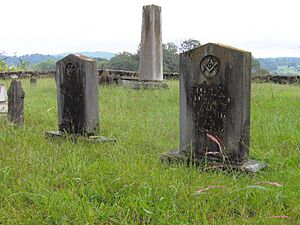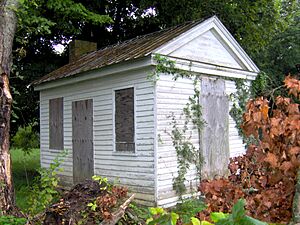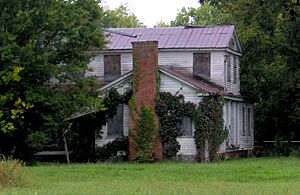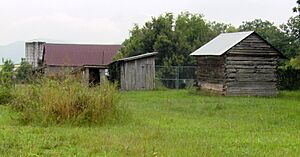Rose Glen (Sevierville, Tennessee) facts for kids
Rose Glen was a large farm in Sevier County, Tennessee, built before the American Civil War. It was one of the biggest and most successful farms in Sevier County. It was also one of the most productive farms in East Tennessee. Today, the farm no longer operates. However, the main house and several other buildings are still standing. These include a doctor's office, a loom house, and a special type of barn. These buildings are now on the National Register of Historic Places. This means they are important historical sites.
Rose Glen was started in the late 1840s. Dr. Robert H. Hodsden (1806–1864) built it. He was a doctor and a politician in Sevier County. By 1860, he was one of the richest people in the county. Dr. Hodsden helped care for the Cherokee people during the "Trail of Tears" in the 1830s. He also served in the Tennessee state government from 1841 to 1845. Even though he owned enslaved people, Hodsden strongly supported the Union during the Civil War. He was part of a meeting in Greeneville, Tennessee in 1861. Rose Glen is still owned by Dr. Hodsden's family today.
Contents
Where is Rose Glen Located?
Rose Glen is found where State Highway 416 and Old Newport Highway meet. This is a few miles east of Sevierville, Tennessee. It is near a community called Harrisburg. The main house and the land around it are on the east side of the Middle Fork of the Little Pigeon River. This is about half a mile south of where the Middle Fork joins the East Fork. The house is across the street from the Walters State Community College campus in Sevier County.
The Story of Rose Glen
Who Was Robert Hodsden?
Robert Hodsden was born in Smithfield, Virginia in 1806. He first worked as a tailor in different cities. Then, he decided to study medicine. He earned his medical degree in 1833 from Thomas Jefferson University in Philadelphia. After that, Hodsden joined a doctor's practice in Maryville, Tennessee. He married his first wife, Elizabeth Hook, in 1832. She passed away in 1842.
In 1838, Hodsden became a doctor for the Cherokee Removal. This sad event is often called the "Trail of Tears." Hodsden was a member of the Whig Party. He was elected to the Tennessee state government in 1841. He represented Blount County for four years. In 1843, after his first wife died, Hodsden married Mary Brabson-Shields. Her father, John Brabson, owned the Brabson's Ferry Plantation. He gave Mary the land that became Rose Glen as a wedding gift.
Hodsden and Mary first lived in Maryville. Later, they moved to Rose Glen. They finished building the main house and a smaller building (villa) in 1850. In the ten years after Rose Glen was built, Hodsden became the first president of the East Tennessee Medical Society. He also helped start Sevier County's first masonic society.
Even though he owned enslaved people, Hodsden strongly supported the Union during the Civil War. This was true even though his wife's family supported the South leaving the Union. He represented Sevier County at a Union meeting in June 1861. In November of that year, he was held by Southern authorities. They thought he helped Union supporters damage railroad bridges. Hodsden was later released. He returned to Rose Glen, where he passed away in 1864. He was buried in the Brabson Cemetery.
The Rose Glen Farm Story
In the early 1800s, Rose Glen was part of a farm called the "Bush place." George Bush, an early settler, started it. By the 1830s, John Brabson owned the Bush place. When his daughter, Mary, married David Shields in 1837, Brabson gave them the Bush place as a wedding gift. Shields built a house there and named the farm "Rose Glen." But he died suddenly in 1839.
In 1843, Mary Brabson-Shields married Robert Hodsden. Hodsden then owned the Bush place. In 1846, Hodsden and his wife began building the main house and villa at Rose Glen. They finished it in 1850.
By 1860, Rose Glen had grown very large. It was the most valuable farm in Sevier County. The farm had many animals, including horses, cattle, sheep, and hogs. Hodsden and fifteen enslaved people grew a lot of crops. These included oats, wheat, sweet potatoes, and hay. They also produced wool, molasses, and butter. Rose Glen's rice crop was one of the biggest in East Tennessee. The farm even had a small place to make wine.
On January 27, 1864, Rose Glen was part of a small battle. This was called the Battle of Fair Garden. Union and Confederate soldiers fought near the farm. In 1873, Abraham Jackson Hicks took over Rose Glen. He married Hodsden's daughter, Mary Pasteur Hodsden. After Hicks passed away, Rose Glen went to his oldest son, John Hodsden Hicks.
Buildings at Rose Glen
The Rose Glen House
A historian named Robbie Jones said the Rose Glen house was the "most impressive" house built in Sevier County before the Civil War. The house has a Greek Revival style. It has a two-story middle part with one-story sections on each side. The front of the middle part has a porch with square columns. There are also enclosed porches on the back of the house.
The house sits on a foundation mostly made of limestone. One side rests on a brick foundation. This might be from the older Shields house. A staircase on one of the back porches leads to the second floor. This floor has three bedrooms. The house has three cellars. One of them, under the middle part, was used as a kitchen. The house also has three brick chimneys.
The design of Rose Glen was inspired by an architect named Minard Lafever. His "Design for a Country Villa" was in his building guides. This design called for a main house with two wings. It also included two other buildings placed evenly with the house. At Rose Glen, these two buildings were used as an office and a loom house. They were connected to the main house by paths with flowers. The office and loom house look similar to the main house. They have the same outside wood and brick chimneys. A rose garden was kept between these smaller buildings and the main house.
Other Buildings at Rose Glen
Besides the loom house and Hodsden's office, other buildings still stand at Rose Glen. These include a special double-cantilever barn, a smokehouse, a springhouse/wellhouse, a hay barn, a concrete silo, and an outhouse. Hodsden added the smokehouse. His son-in-law, Abraham Hicks, likely built the springhouse and the double-cantilever barn. Hodsden's grandson, John Hodsden Hicks, added the corn crib, silo, and a different type of hay barn.
The smokehouse was built around 1850. It is made of cut logs. It has a wooden door with iron hinges. The double-cantilever barn was built in the late 1800s. It still has its original design, though a tractor shed was added later. The hay barn is across the street from the main house. It has a gambrel roof and was built in the 1920s. Most of these other buildings are made of wood frames, except for the smokehouse.








